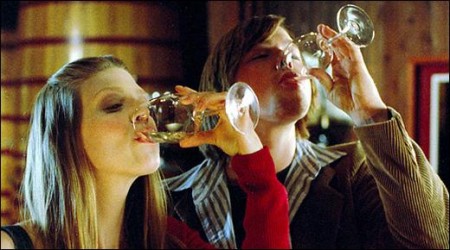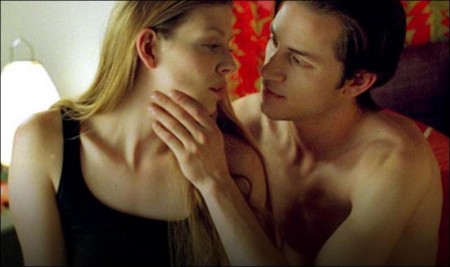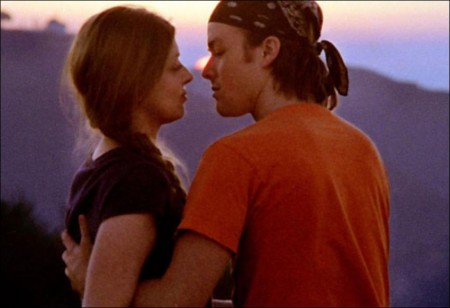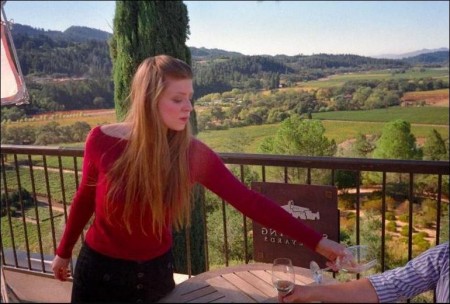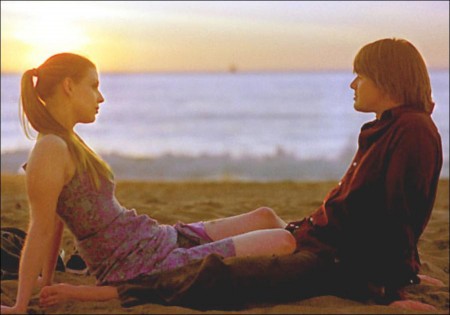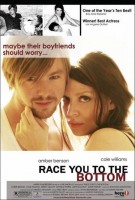Tagline: Maybe their boyfriends should worry…
Nathan, a bisexual travel writer, gets into a passionate affair with his travelling companion Maggie as they explore the romantic hot-spots of Napa Valley, despite the fact that they both have boyfriends back home.
“Race You to the Bottom” centers around a beautifully complicated and heated love affair between two young 20-somethings: a straight woman and her best friend, a gay man. Starring young actors Cole Williams (“Harry and Max”) and Amber Benson (“Buffy the Vampire Slayer”) in career-making lead roles, “Race You to the Bottom” is a vibrant, sexy artistic achievement and a cultural milestone in reflecting a fast changing new world of fluid sexuality.
Propelled by the exhilaration of their six-month secret affair, gay Nathan and straight Maggie embark on a sun-drenched road trip through Napa Valley wine country, all the while leaving their respective boyfriends behind. The lovers try to define their relationship on their own terms: sensual, liberating and rebellious, but also one fraught with complications that they might not have the maturity to overcome. The result is an unlikely love story with sharply drawn, intelligent and flawed characters. As these two hedonists tear through Northern California, the film reminds us of the glorious moments when romance seems to have no boundaries.
Short Synopsis
Nathan and Maggie are in the throes of a passionate affair. They’re young, good-looking, and both have boyfriends. When Nathan is assigned to write a travel article on romantic hot-spots in Napa Valley, these unconventional lovers test the limits of the sensuality and fantasy that bond them.
Long Synopsis
Nathan (Cole Williams), 24, is a travel journalist from Los Angeles assigned to write about romantic hot-spots in California’s Napa Valley. Maggie (Amber Benson), 24, is trying to figure out how to turn her political science degree into a career. Although Nathan and Maggie both have boyfriends, they are in the throes of a passionate affair, and this will be their first weekend away together.
En route to Napa, they visit Joe (Justin Hartley) and Carla (Danielle Thomas) – friends of Maggie’s from college. A spontaneous seduction brings to light their hopes and fears, forcing Nathan and Maggie to confront the reality of their romance as they drive through a gold and green autumn in wine country. Each turn is a test as these unconventional lovers try to rescue the sensuality and fantasy that bonds them.
About the Film Subject Matter
“Race You to the Bottom” centers around a beautifully complicated and heated love affair between a 20-something straight woman and her best friend, a 20-something gay man. Starring young actors Cole Williams and Amber Benson (“Buffy, The Vampire Slayer”) in career-making lead roles, “Race You to the Bottom” is a vibrant, sexy artistic achievement and a cultural signpost in reflecting a fast-changing new world of fluid sexuality.
In the spirit of “Two for the Road” or “Bob & Carol & Ted & Alice,” “Race You to the Bottom” is a window into the sexual mores of a new generation. From the pages of Myspace to the cover of New York Magazine, Generation Y is experimenting in a world without definitions.
Do the terms bisexual, gay and straight really no longer have a purpose? Can a more utopian view of sexuality replace what might have previously been a divisive system of categorizing love? The lead characters in the film, Nathan and Maggie, plunge into this dilemma as they try to define a relationship on their own terms: sensual, liberating, rebellious, but also fraught with complications that they might not have the maturity to overcome.
In this larger exploration of a social phenomenon, “Race You to the Bottom” is also a sharp examination of how two people use each other to hide from certain fears in their own coming-of-age.
Nathan and Maggie both have boyfriends, but they have been conducting a secret affair with each other for more than six months. Maggie is avoiding finding a career, finding a husband, or settling on any definition or restrictions for her own life. She sees the relationship with Nathan as a childhood fantasy — as she says, “an endless stream of now.” Because Nathan is gay, she’s relieved from the normal expectations that might be placed on a young woman, and can indulge in this romantic fantasy because she intuits it will have an inevitable conclusion.
Nathan, also, is avoiding the expectations that come with being a gay man in America. Turned off by gay culture and values, and dreaming of the pleasures of a traditional, heterosexual relationship, Nathan is also playing out a fantasy. As he says, his “biological imperative” calls for certain needs to be fulfilled, but Maggie would be the woman he would settle down with if could be straight.
Stories of love between gay men and straight women have been told in the past, but generally it is the sexual component that gets in the way. However, in the context of a new world without definitions, the erotic element might actually be the strongest and simplest aspect of this love affair, while the real difficulty arises about how the future might work or what the expectations are on each side.
All of this is played out over the course of a wine-filled, bright and golden autumn in Napa Valley. Despite the tough questions and hard realizations, “Race You to the Bottom” is ultimately a warm, joy-filled celebration of the eccentricities of youth and the vigor of a hot-blooded, rebellious affair. As these two hedonists tear through Northern California, the film reminds us of the glorious moments when romance seems to have no boundaries.
About the Production
Race You to the Bottom started as an exploration of how certain personal needs are played out in relationships. Initially the script consisted of a series of conversations — meditations, during the course of a driving trip from Los Angeles to San Francisco, on what characterizes the dynamic between a straight woman and a gay man. The sensual and romantic interaction that my two characters seemed to be experiencing was one that is rarely explored in a “gay-themed” feature film. It was layered with the complexity of unfulfilled expectations and ulterior motives, and therein I saw the potential for a moving film.
As the plot emerged, the themes of the film began to play themselves out more dramatically, as the characters faced situations and external pressures along the way. The process of workshopping many of the scenes with acting/directing coach Joan Scheckel helped bring the ideas of the film into sharper perspective. And although the script remained dialogue-driven, as we progressed it took on a more cinematic energy and form. It was perhaps not until editing was well underway, months later that the relationship between words and images would find its equilibrium.
The director of photography, Marco Fargnoli, was the first crewmember to become involved. While the script was still in its early stages, we were introduced over lunch by a mutual filmmaker friend. Marco’s questions and thoughts on the aesthetics of the film helped the script come to its final form. One of the great pleasures of making this movie was working with him — a “perfect collaboration,” as I have told him many times.
Over the course of the next few months, I took a job as script supervisor on a low-budget feature called Harry and Max. The director, Christopher Munch, has always been an inspiration to me and the chance to work in this position was a good way to learn more about the super low-budget independent filmmaking process. This invaluable experience led me to Roni Deitz, who eventually agreed to produce the film. Roni is that rare producer who knows everything, and is “in the game” for all the right reasons: To do good work, have fun, and run a smooth production.
Meeting Amber Benson was perhaps the first moment when I felt the script would actually come to life. Strangely (or not-so-strangely), she was the first actress to read for the part. Before we launched into the audition, Amber told me that she loved the script but hated the ending. I was immediately smitten. Amber brought intelligence to her reading that I had hoped to find, but also a vulnerability that I was not expecting. To the horror of the casting director, I read the part of the male lead during Amber’s callback audition, and felt we had an immediate chemistry.
Casting Nathan was the opposite experience. We couldn’t find anyone. Cole Williams, who starred in Harry and Max, was staying in my spare room throughout the casting process. Cole always had a unique understanding of the script, but had played a much younger character in Harry and Max. To me, he was always the 15-year-old boy band singer of that film, and not the more mature-looking 25-year-old. A week before production began, we still hadn’t cast the male lead and it was looking like we might shut down. At the end of our final casting session, Cole appeared with a new haircut, facial hair, and demanded to read for the part. Turns out he was perfect and we had already become great friends, so I knew we could work together. Amber and I had been rehearsing for a few weeks, but the three of us worked intensely before production began — blocking the scenes and getting Cole up to speed. These two actors had immediate chemistry and genuinely liked each other a great deal, so it ended up being a perfect match.
By most filmmaking standards, our 20-day shooting schedule was extremely tight. Split between Napa Valley and Los Angeles, we were constantly at odds with time. Adding to this, the majority of the film takes place outside, and many of our long dialogue scenes could’ve been ruined had the weather not cooperated, or had the schedule not been so perfectly planned by Roni Deitz. Our tiny, dedicated crew believed passionately in the project.
Most notable were the super-human efforts of Fred Helm and Lee Ascher (production sound mixers), Doran Meyers (art director), and Kristen Anacker (costume designer). Roni and I have frequently joked that our production was blessed. When it was supposed to rain and be foggy on our San Francisco beach shoot day, we showed up to the warmest, clearest October day that San Francisco had seen in years. Every location in Napa was cooperative and the production is indebted to them for their generosity.
Editing began two weeks after we wrapped. I was lucky to enlist Annette Davey, a veteran film editor, to cut the project together. Annette had read the script before production, and given me tips on common mistakes of the first time director. (“Oftentimes they overshoot the actors from behind. We want to see their faces!”) Working with Annette was like attending a master-class in film editing. The structure of the story was constantly changing and evolving, and the greatest lesson — you must try everything! — proved fruitful as we chiseled the movie into its final form.
When we finally locked the film, Christopher Munch agreed to take on the thankless role of post-production supervisor. Having never made a film on 35mm, I am convinced we would still be working today had he not so courageously and generously taken on this position. Our first task after the film was “locked” was to find a composer. Annette introduced me to Ryan Beveridge whose score captured the “Berkeley” vibe of the movie, and brought an emotional element that had not been there.
Two songs by M.C. Honky and Eric McKeown were part of the temp, and we were able to license them. Fred Helm oversaw the sound editing and Mark Rozett, another veteran, mixed the film on a meager budget and tight schedule. Ronna Wallace has since come on as our sales representative, and like many other members of the crew, I am grateful for her experience and wisdom.
Production notes provided by Regent Releasing, Here! Films.
Race You to the Bottom
Starring: Amber Benson, Cole Williams, Jeremy Lelliott, Danielle Harris, Justin Zachary
Directed by: Russell Brown
Screenplay by: Russell Brown
Release Date: March 30th, 2007
MPAA Rating: R for sexual content, language and brief drug use.
Studio: Regent Releasing, Here! Films
Box Office Totals
Domestic: $5,468 (100.0%)
Foreign: —
Total: $5,468 (Worldwide)
